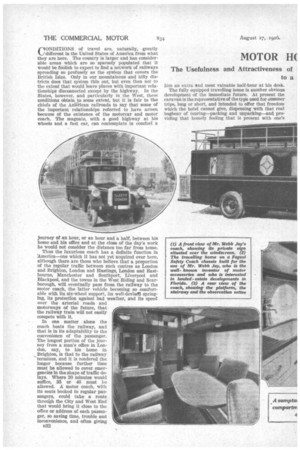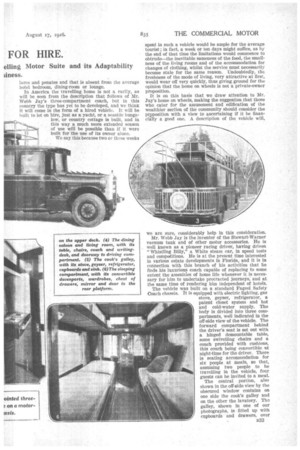MOTOR H( FOR HIRE.
Page 16

Page 17

Page 18

If you've noticed an error in this article please click here to report it so we can fix it.
The Usefulness and Attractiveness of to a Ming Motor Suite and its Adaptability dness.
CONDITIONS of travel are, naturally, greatly different in the United States of America from what they are here. The country is larger and has considerable areas which are so sparsely populated that it would be foolish to expect to find a network of railways spreading so profusely as the system that covers the British Isles. Only in our mountainous and hilly districts does that system thin out, but even then not to the extent that would leave places with important relationships disconnected except by the highway. In the States, however, and particularly in the West, these• Conditions obtain to some extent, but it is fair to the chiefs of the Aril-Rican railroads to say that seine of the important relationships referred to have arisen because Of the existence of the motorcar and motor coach. The magnate, with a good highway at his wheels and a fast car, can contemplate in comfort a
journey of an hour, or an hour and a half, between his home and his office and at the close of the day's work he would not consider the distance too far from home.
Thus the luxurious coach has a definite function in 'America—one which it has not yet acquired over here, although there are those who believe that a proportion
of the regular traffic between such centres as London and Brighton, London and Hastings, London and East
bourne, Manchester and Southport, Liverpool and Blackpool, and the towns in the West Riding and Scarborough, will eventually pass from the railway to the motor coach, the latter vehicle becoming so comfort able with its six-wheel support, its well-devisell springing, its protection against bad weather, and its speed over the arterial roads and motorways of the future, that the railway train will not easily compete with it.
In one matter alone the coach beats the railway, and that is in its adaptability to the convenience of the passenger. The longest portion of the journey from a man's office in London, say, to his home in Brighton, is that to the railway terminus, and it is rendered the longer because further time must be allowed to cover emergencies in the shape of traffic delays. Where 20 minutes would suffice, 35 or 40 must be allowed. A motor coach, with Its seats booked to regular passengers, could take a route through the City and West End that would bring it close to the office or address of each passenger, so saving time, trouble and inconvenience, and often giving,
B32 him an extra and most valuable half-hour at his desk.
The fully equipped travelling home is another obvious development of the immediate future. At present the caravan is the representative of the type used for summer trips, long or short, and intended to offer that freedom which the hotel cannot give, dispensing with that real bugbear of touring—packing and unpacking—and providing that homely feeling that is present with one's lares and palates and that is absent from the average hotel bedroom, dining-room or lounge.
In America the travelling home is not a rarity, as will be seen from the description that follows of Mr. Webb Jay's three-compartment coach, but in this country the type has yet to be developed, and we think it will come in the form of a hired vehicle. It will be built to let on hire, just as a yacht, or a seaside bungalow, or country cottage is built, and in this way a much more extended season of use will be possible than if it were built for the use of its owner alone.
We say this because two or three weeks spent in such a vehicle would be ample for the average tourist ; in fact, a week or ten days might suffice, as by the end of that time the limitations would commence to obtrude—the inevitable sameness of the food, the smallness of the living rooms and of the accommodation for changes of clothing, whilst the service must necessarily become stale for the same reason. Undoubtedly, the freshness of the mode of living, very attractive at first, would wear off very quickly, thus giving ground for the opinion that the home on wheels is not a private-owner proposition.
It is on this basis that we draw attention to Mr. Jay's home on wheels, making the suggestion that those who cater for the amusement and edification of the wealthier section of the community should consider the pr.oposition with a view to ascertaining if it be financially a good one. A description of the vehicle will, we are sure, considerably help in this consideration.
Mr. Webb day is the inventor of the Stewart-Warner vacuum tank and of other motor accessories. He is well known as a pioneer racing driver, having driven "Whistling Billy," a White steam car, in speed tests and competitions. He is at the present time interested in various estate developments in Florida, and it is in connection with this branch of his activities that be finds his luxurious coach capable of replacing to some extent the amenities of home life whenever it is necessary for him to undertake protracted journeys; and at the same time of rendering him independent of hotels.
The vehicle was built on a standard Fageol Safety Coach chassis. It is equipped with electric lighting, gas stove, geyser, refrigerator, a patent closet system and hot and cold-water supply. The body is divided into three compartments, well indicated in the off-side view of the vehicle. The forward compartment behind the driver's seat is set out with a hinged demountable table, some swivelling chairs and a couch provided with cushions, this couch being convertible at night-time for the driver. There is seating accommodation for six people at meals, so that, assuming two people to be travelling in the vehicle, four guests can be invited to a meal.
The central portion, also shown in the off-side view by the obscured window contains on one side the cook's galley and on the other the lavatory. The galley, shown in one of our photographs, is• fitted up with cupboards and drawers, over which are a sink and drain board, the refrigerator also being below. Storage for cooking utensils, table ware, cutlery, glass, etc., is provided, every useful corner in the dining saloon and galley being utilized.
The lavatory contains a washing basin with hot and cold running water and a toilet with a chemical disinfectant tank below. Water for the various services is contained in a 70-gallon tank built into the roof.
The rear compartment is set out as a sleeping saloon' and dressing-room for Mr. and Mrs. Jay, the two convertible davenports making very comfortable berths. At the rear are a dressing table, wardrobes, chest of drawers, mirror, etc., and the curtaining, lighting, ventilation and other appointments are well carried out. From the sleeping compartment access can be obtained to the rear platform, which is surrounded by artistic guard railings, upon which is carried a spare wheel. Above the clerestory roof, which gives additional headroom to the interior, is an observation settee with seats facing outwards on all, four sides. Access is given to the upper deck by a staircase from the rear platform and guard rails are provided, the whole of the metal work being nickel-plated.
Both passenger compartments are upholstered in dark-blue mohair velour, the curtains (which, by the way, are sunproof) being chosen to match. XII the woodwork is of hand-rubbed mahogany, and nickelplating is employed for all interior metal work.
The only detail of which we have no information concerns the chef and steward (presumably the two services being performed by the one person) and his sleeping accommodation. The difficulty here presented could be partly overcome if the driver were also the chef and steward or if Mrs. Jay undertook the culinary duties, leaving the setting out of the table, the service, clearing away, etc., to the driver, but neither is an ideal solution, for obvious reasons.
The Fageol chassis has a Hall-Scott six-cylindered engine and the vehicle can easily attain 60 miles per hour.




























